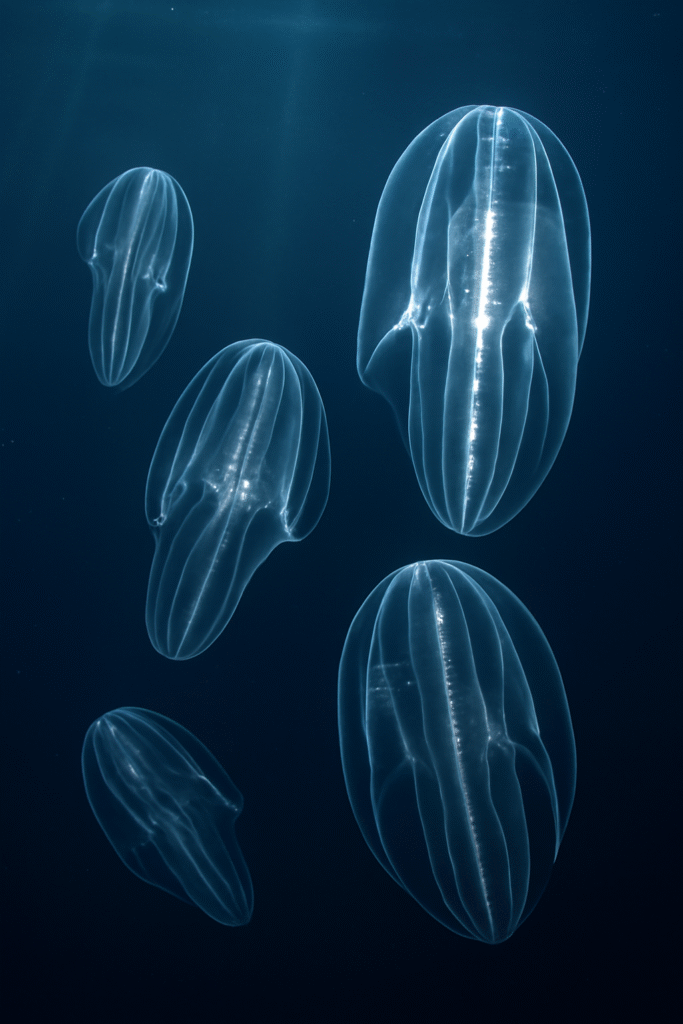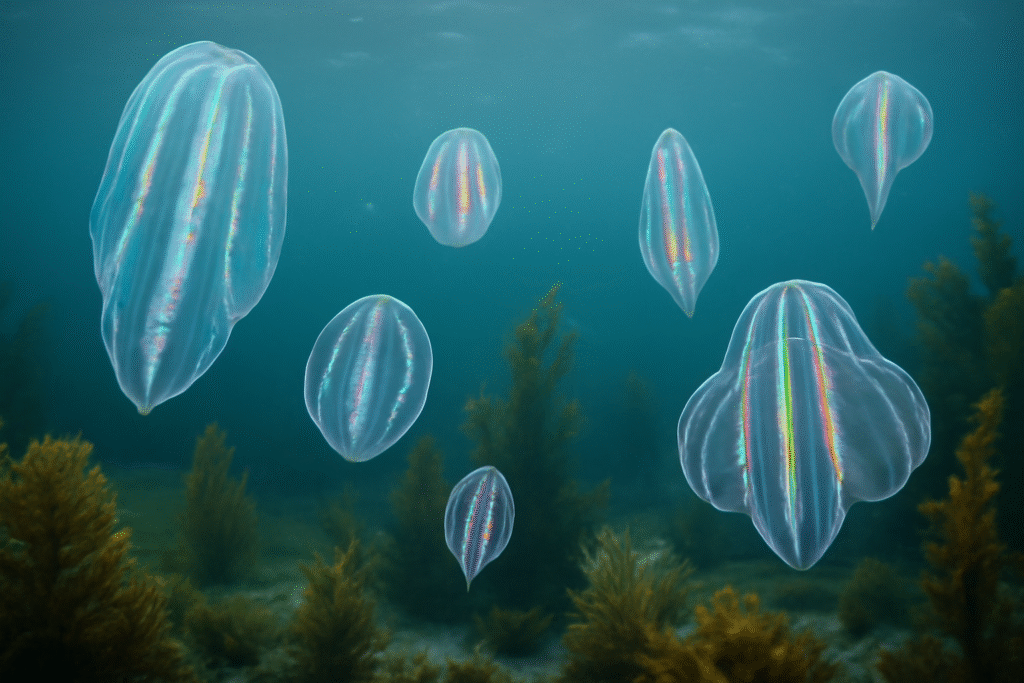Comb Jellies That Age in Reverse: Unlocking the Secrets of Nature’s Time-Travellers
In a remarkable discovery that challenges our understanding of biological ageing, scientists have identified a marine species capable of reversing its age. The species in question, Mnemiopsis leidyi—a type of comb jelly—is not only able to defy time but also reveals clues about the earliest branches of animal evolution. This breakthrough holds promise for research into ageing, regeneration, and developmental biology.

What Are Comb Jellies?
Comb jellies, or ctenophores, are gelatinous marine invertebrates that drift gracefully through ocean waters, using rows of tiny, hair-like structures called “ctenes” for movement. While they may resemble jellyfish, comb jellies belong to an entirely separate phylum and have a distinct evolutionary lineage.
Among them, Mnemiopsis leidyi, also known as the sea walnut, is a well-known species found in the western Atlantic Ocean. These creatures are typically transparent, bioluminescent, and known for their regenerative abilities. But what has recently captured the attention of biologists is something far more extraordinary—their ability to age in reverse.
The Discovery: Accidental but Groundbreaking
The discovery of reverse ageing in Mnemiopsis leidyi was somewhat serendipitous. Dr. Joan J. Soto-Angel, a postdoctoral researcher at the University of Bergen in Norway, was observing adult comb jellies in his laboratory when something unusual occurred. One of the adult jellies in the tank appeared to have transformed into a larva. Initially, he thought it might have been a mistake or contamination, but genetic tracking confirmed that the larva was in fact the same individual.
This surprising transformation led Soto-Angel and his colleagues to investigate further. Through controlled laboratory experiments, they exposed the comb jellies to various stress conditions to determine whether this transformation could be intentionally triggered. What they discovered stunned the scientific community: Mnemiopsis leidyi can indeed revert to an earlier stage of development under stress.
How Does the Reverse Ageing Work?
The research team tested two primary stress conditions:
- Starvation
- Physical Injury (Lobectomy)
Starvation Experiments
When adult comb jellies were deprived of food for extended periods, some began to shrink, simplify in form, and eventually adopt characteristics of their earlier larval stage, called the “cydippid” stage. This stage is marked by a more spherical shape and different feeding behavior. Remarkably, once food was reintroduced, these reverted organisms could redevelop into fully functioning adults, completing a full cycle of reverse and forward development.

Injury-Induced Regression
In another set of experiments, scientists surgically removed parts of the adult jelly’s body—specifically the lobes used for feeding. This triggered a more consistent and rapid form of age regression. Unlike the starvation group, a significantly higher proportion of the injured comb jellies reverted to their larval state. This suggests that physical trauma is a stronger trigger for de-ageing than starvation alone.
What Makes This So Unique?
While certain species like the “immortal jellyfish” (Turritopsis dohrnii) are known to undergo biological reversal of ageing, Mnemiopsis leidyi is unique in several ways:
- Independent Evolution: Ctenophores like comb jellies are thought to have evolved independently from other animal lineages. This makes their biological systems vastly different from those of cnidarians (jellyfish, corals) and bilaterians (animals with bilateral symmetry, including humans).
- Complex Nervous System: Unlike Turritopsis, comb jellies possess a decentralized nerve net and sensory organs. How this nervous system reorganizes or simplifies during reverse development remains a mystery.
- First Known Reversal in Ctenophores: This is the first recorded case of reverse development in any ctenophore species. It raises the question: could other marine animals, especially those with regenerative capabilities, possess similar traits that have yet to be discovered?
Biological and Evolutionary Implications
A Window Into Early Evolution
Comb jellies are believed to be among the earliest branches on the animal family tree, dating back over 700 million years. Some hypotheses suggest that they may have even predated sponges in evolutionary history. If these creatures have carried the ability to revert their life stage across hundreds of millions of years, it could indicate that reverse development was an ancestral trait, not a novel one.
Plasticity in Animal Life Cycles
The idea that a complex animal can revert to a juvenile form contradicts our standard biological model: birth → growth → reproduction → death. Most animals are hardwired to follow this sequence, but Mnemiopsis leidyi breaks that chain. This discovery opens the door to redefining what we understand about life cycle plasticity and developmental biology.
Potential Applications for Human Health and Ageing Research
Although it’s a long stretch to compare humans with comb jellies, the mechanisms involved in such drastic biological transformations could inform future medical research. For instance:
- Regenerative Medicine: Understanding how comb jellies dismantle and rebuild their tissues could help scientists develop better tissue engineering techniques or organ regeneration therapies.
- Neuroplasticity: How does the jelly’s nerve net adapt during reverse development? This question could lead to new insights into neural plasticity, especially in recovering from spinal injuries or degenerative diseases.
- Ageing and Rejuvenation: If researchers can decode the genetic triggers and biochemical pathways involved in reverse ageing, it may eventually contribute to therapies that slow, pause, or even reverse ageing processes in humans.
However, it is essential to note that comb jellies are evolutionarily distant from mammals, and what works for them may not be applicable to complex vertebrates like us. But as with all great scientific discoveries, even a small insight from a distant species can spark revolutionary change.
Challenges and Unanswered Questions
While the findings are revolutionary, they raise a host of new scientific questions:
- What molecular mechanisms drive this transformation?
Are specific genes switched on or off during stress-induced regression? - How is memory retained (if at all) through regression?
Since comb jellies have a nerve net and sensory organs, does regression erase any form of neural memory? - Is this ability present in other ctenophores or marine invertebrates?
If yes, this could signal a broader evolutionary pattern. - Is this process truly age reversal or simply dedifferentiation?
Scientists are still debating whether this phenomenon qualifies as a reversal of age or a form of dedifferentiation—a return to an earlier, simpler form without resetting biological “age.”
The Bigger Picture: Nature’s Hidden Blueprint for Survival
Reverse ageing in comb jellies may be an evolutionary strategy developed to survive extreme conditions. By reverting to a larval stage, the organism:
- Requires fewer resources to survive.
- Can potentially escape or avoid harmful environmental conditions.
- May enhance its chances of long-term survival.
This ability could reflect how early life on Earth adapted to volatile environments. Rather than perish, organisms may have evolved ways to simplify and wait out the storm.
Public and Scientific Response
The discovery has drawn significant attention from both marine biologists and medical researchers. It’s not just a quirky fact about ocean life—it’s a window into possibilities for longevity, resilience, and transformation. The story of a creature turning back time offers not just scientific intrigue, but also philosophical reflection on the nature of life, growth, and change.
Conclusion
The comb jelly Mnemiopsis leidyi has revealed a stunning biological trait: the ability to reverse its age and return to a larval stage under stress. This process, once thought impossible in complex animals, challenges fundamental concepts in biology and evolution. While we’re still far from translating this into human medicine, the implications for understanding ageing, regeneration, and early animal development are profound.
As science continues to uncover nature’s hidden blueprints, one thing is clear—life is far more flexible, creative, and mysterious than we ever imagined.
References
- Indian Express – Researchers discover new species of marine creatures that can age in reverse
- PNAS – Proceedings of the National Academy of Sciences (Journal where the study was published)
- Gizmodo – “This Transparent Sea Creature Can Age in Reverse”
- LiveScience – “Comb Jellies Can Age in Reverse”
- ScienceAlert – “Wild Discovery Reveals That Comb Jellies Can Age in Reverse”

Pingback: Cestum | Zoologyverse | 2025